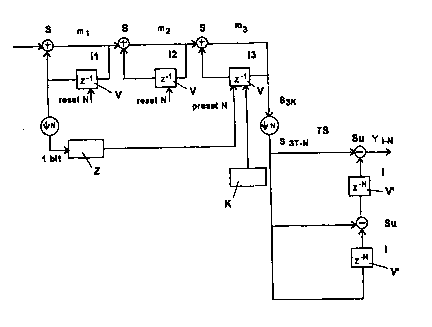Some of the information on this Web page has been provided by external sources. The Government of Canada is not responsible for the accuracy, reliability or currency of the information supplied by external sources. Users wishing to rely upon this information should consult directly with the source of the information. Content provided by external sources is not subject to official languages, privacy and accessibility requirements.
Any discrepancies in the text and image of the Claims and Abstract are due to differing posting times. Text of the Claims and Abstract are posted:
| (12) Patent Application: | (11) CA 2272656 |
|---|---|
| (54) English Title: | COMB FILTER |
| (54) French Title: | FILTRE EN PEIGNE |
| Status: | Deemed Abandoned and Beyond the Period of Reinstatement - Pending Response to Notice of Disregarded Communication |
| (51) International Patent Classification (IPC): |
|
|---|---|
| (72) Inventors : |
|
| (73) Owners : |
|
| (71) Applicants : |
|
| (74) Agent: | SMART & BIGGAR LP |
| (74) Associate agent: | |
| (45) Issued: | |
| (86) PCT Filing Date: | 1998-08-21 |
| (87) Open to Public Inspection: | 1999-04-01 |
| Examination requested: | 2001-05-09 |
| Availability of licence: | N/A |
| Dedicated to the Public: | N/A |
| (25) Language of filing: | English |
| Patent Cooperation Treaty (PCT): | Yes |
|---|---|
| (86) PCT Filing Number: | PCT/DE1998/002453 |
| (87) International Publication Number: | WO 1999016169 |
| (85) National Entry: | 1999-05-21 |
| (30) Application Priority Data: | ||||||
|---|---|---|---|---|---|---|
|
The invention relates to a comb filter consisting of integrators (I1, I2, I3)
connected in series, to which a digital data flow with high scanning rate is
fed in order to supply a digital data flow with a lower scanning rate. The
most significant bits of the digital data flow are reset in the first and
second integrators (I1, I2), whereby the resetting of the bits in the first
integrator (I1) is stored in a counter (Z). The count of the counter (Z) is
fed to the most significant bits of the last integrator (I3) during reset time.
L'invention concerne un filtre en peigne constitué d'intégrateurs (I1, I2, I3) montés en série, auxquels est conduit un courant de données numérique, à une haute fréquence d'échantillonnage, pour produire un courant de données numérique à une fréquence d'échantillonnage plus basse. Les bits de poids fort du courant de donnée numérique sont remis à zéro dans le premier et dans le second intégrateur (I1, I2), la remise à zéro des bits dans le premier intégrateur (I1) étant mémorisée dans un compteur (Z). L'état du compteur (Z) est entré, au moment de la remise à zéro, dans les bits de poids fort du dernier intégrateur (13).
Note: Claims are shown in the official language in which they were submitted.
Note: Descriptions are shown in the official language in which they were submitted.

2024-08-01:As part of the Next Generation Patents (NGP) transition, the Canadian Patents Database (CPD) now contains a more detailed Event History, which replicates the Event Log of our new back-office solution.
Please note that "Inactive:" events refers to events no longer in use in our new back-office solution.
For a clearer understanding of the status of the application/patent presented on this page, the site Disclaimer , as well as the definitions for Patent , Event History , Maintenance Fee and Payment History should be consulted.
| Description | Date |
|---|---|
| Application Not Reinstated by Deadline | 2004-08-23 |
| Time Limit for Reversal Expired | 2004-08-23 |
| Deemed Abandoned - Failure to Respond to Maintenance Fee Notice | 2003-08-21 |
| Amendment Received - Voluntary Amendment | 2003-05-05 |
| Amendment Received - Voluntary Amendment | 2001-06-11 |
| Letter Sent | 2001-05-30 |
| All Requirements for Examination Determined Compliant | 2001-05-09 |
| Request for Examination Received | 2001-05-09 |
| Request for Examination Requirements Determined Compliant | 2001-05-09 |
| Inactive: Cover page published | 1999-08-16 |
| Inactive: IPC assigned | 1999-07-19 |
| Inactive: First IPC assigned | 1999-07-19 |
| Letter Sent | 1999-06-23 |
| Inactive: Notice - National entry - No RFE | 1999-06-23 |
| Application Received - PCT | 1999-06-22 |
| Application Published (Open to Public Inspection) | 1999-04-01 |
| Abandonment Date | Reason | Reinstatement Date |
|---|---|---|
| 2003-08-21 |
The last payment was received on 2002-08-06
Note : If the full payment has not been received on or before the date indicated, a further fee may be required which may be one of the following
Please refer to the CIPO Patent Fees web page to see all current fee amounts.
| Fee Type | Anniversary Year | Due Date | Paid Date |
|---|---|---|---|
| Basic national fee - standard | 1999-05-21 | ||
| Registration of a document | 1999-05-21 | ||
| MF (application, 2nd anniv.) - standard | 02 | 2000-08-21 | 2000-07-18 |
| Request for examination - standard | 2001-05-09 | ||
| MF (application, 3rd anniv.) - standard | 03 | 2001-08-21 | 2001-08-10 |
| MF (application, 4th anniv.) - standard | 04 | 2002-08-21 | 2002-08-06 |
Note: Records showing the ownership history in alphabetical order.
| Current Owners on Record |
|---|
| SIEMENS AKTIENGESELLSCHAFT |
| Past Owners on Record |
|---|
| DIETER DRAXELMAYR |